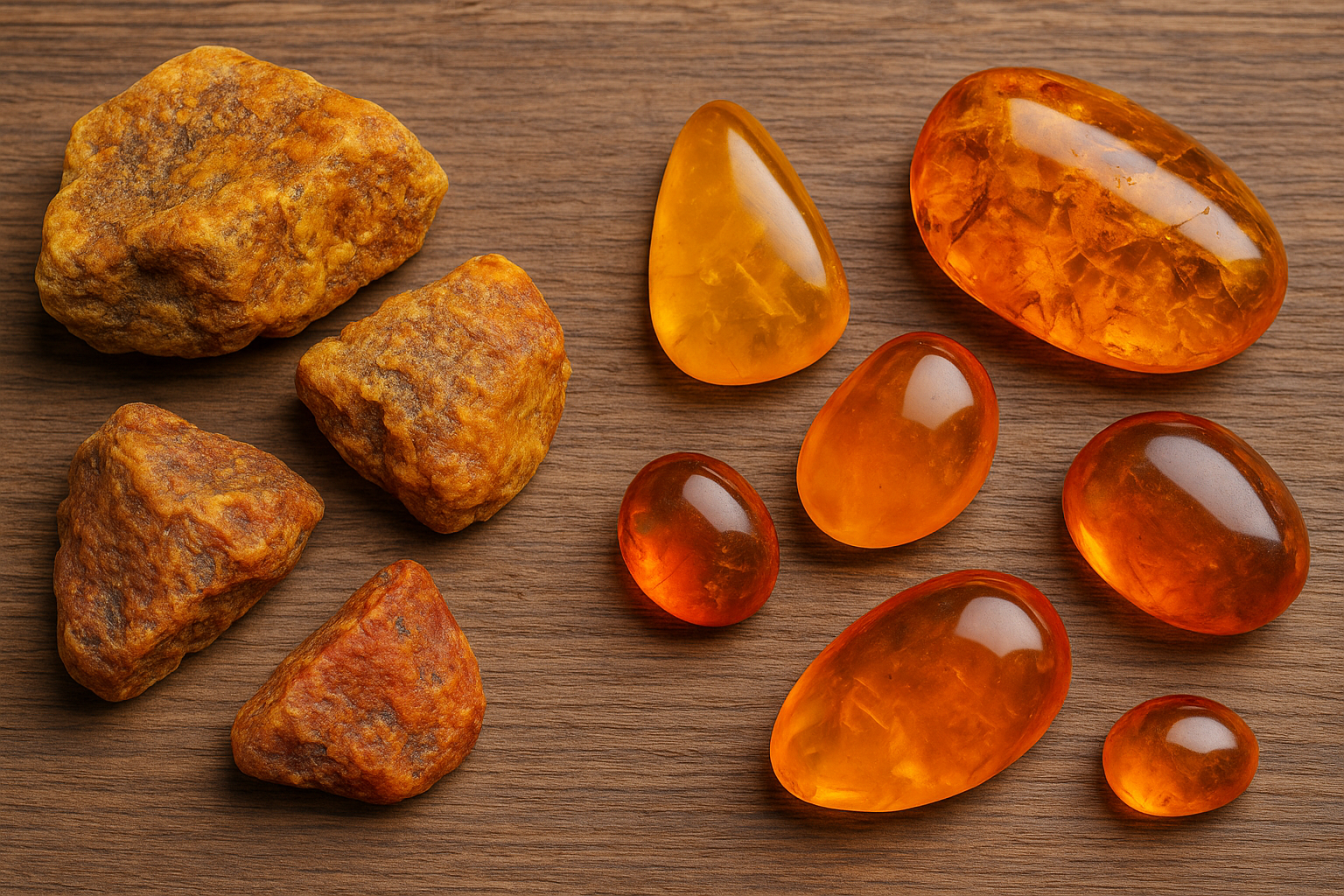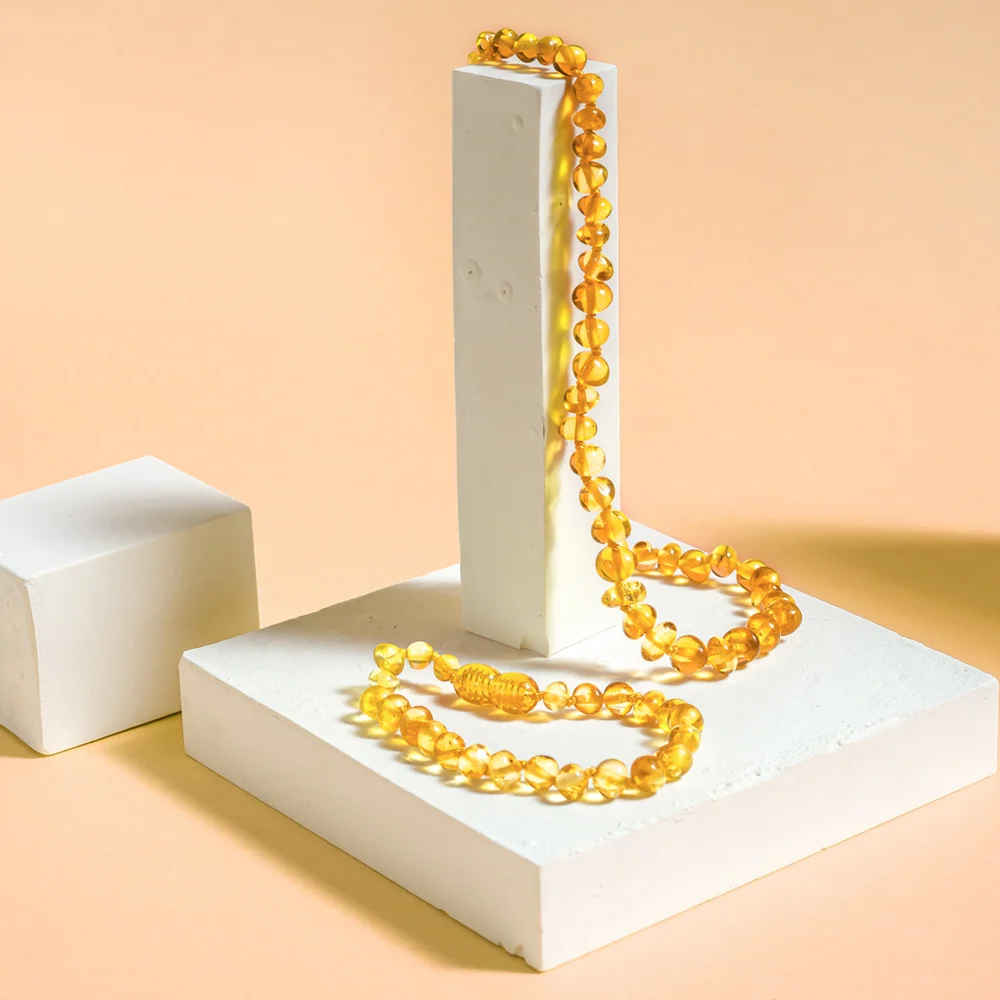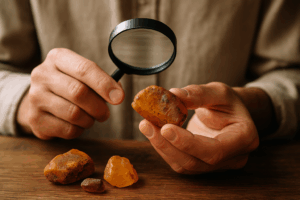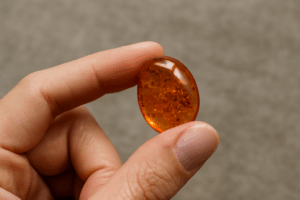Amber is a gem that bridges the gap between nature and history, captivating hearts for centuries with its golden glow and fascinating inclusions. But did you know there’s a world of difference between raw unpolished amber and the smooth, luminous stones you often see in jewelry? In this blog post, we’ll uncover the secrets of both raw and polished Baltic amber—exploring their unique appearances, historical significance, and how to distinguish them. Whether you’re a collector, a jewelry lover, or simply curious about this ancient wonder, join us as we delve into the striking differences and help you choose the perfect form of amber to match your style and spirit.
What is Raw Unpolished Amber?
Raw unpolished amber is a natural form of amber that has been left untouched by any human treatment or refinement. It’s essentially amber in its purest state, just as it was found in the earth or along the shores of the Baltic Sea. Unlike polished amber, which has been cut, shaped, and buffed to a glossy shine, raw amber retains its naturally rugged texture and matte appearance.
This unprocessed form of amber has a captivating, earthy beauty that reveals the true character of the gemstone. Raw amber may display a rough, almost chalky exterior with pits, cracks, or cloudy patches. These natural features are a testament to the millions of years of geological transformation that amber has undergone, from sticky tree resin to a fossilized gem of ancient forests.
One of the most fascinating aspects of raw amber is its inclusions – tiny pieces of ancient plant matter, insects, or air bubbles that were trapped in the resin millions of years ago. In raw form, these inclusions can be more pronounced and provide a unique window into prehistoric ecosystems. For many amber enthusiasts and collectors, the raw, organic state of amber holds a special kind of magic, connecting them directly to the natural world.
How to Identify Raw Amber?
Identifying raw amber can be a rewarding experience for those fascinated by nature’s artistry. Here are some key characteristics to look for:
- Texture and Surface: Raw amber has a rough, often matte finish that feels slightly gritty or chalky to the touch. You may notice pits, cracks, or uneven surfaces – these are natural features that set raw amber apart from its polished counterpart.
- Color and Transparency: The color of raw amber can vary widely, from creamy whites and pale yellows to deep browns or even greenish hues. Raw amber tends to be more opaque, though some pieces might show flashes of internal color when held up to the light.
- Natural Inclusions: One of the most exciting parts of raw amber is its inclusions. Look for tiny bits of plant matter, insects, or other ancient debris trapped inside. These inclusions are often more visible in raw pieces because there’s no polish to hide or distort them.
- Weight and Feel: Genuine raw amber is surprisingly light for its size, thanks to its organic origin. When held in your hand, it often feels warm and slightly resinous, unlike plastic imitations that may feel cold or glassy.
- The Saltwater Test: A classic trick for identifying real amber – raw amber will float in saltwater due to its low density, while most fakes will sink.
- UV Light Test: Raw amber has a natural fluorescence under ultraviolet light, glowing a soft blue or greenish color. This is a reliable way to confirm authenticity.
Whether you’re beachcombing along the Baltic shores or browsing an amber market, learning to identify raw amber can help you appreciate its natural beauty and ancient origins.
What is Polished Amber?
Polished amber is raw amber that has undergone a series of careful treatments to reveal its inner brilliance. Through polishing and shaping, artisans transform the rough, matte exterior of raw amber into a smooth, glossy gemstone that radiates warmth and light. This process highlights the clarity, inclusions, and natural color variations that make each piece unique.
Polishing amber is a delicate art that involves gently sanding and buffing the stone to remove the outer layer and create a glass-like finish. The result is a luminous gem with a silky surface that feels soft and warm to the touch. Polished amber can be shaped into cabochons, beads, pendants, or intricate carvings, making it a popular choice for jewelry and decorative art.
The polished surface not only enhances amber’s aesthetic appeal but also allows light to pass through, illuminating the internal world of the gemstone. Inclusions that might have been hidden or muted in raw form become more vivid and detailed, turning each polished piece into a miniature time capsule of ancient life.
How to Identify Polished Amber?
Polished amber is instantly recognizable by its smooth, glossy surface and refined appearance. Here’s how to spot it:
- Smoothness and Shine: Unlike raw amber, polished amber has a glassy, high-luster finish that catches the light and creates a warm, inviting glow. The surface is smooth to the touch, without the pits or cracks seen in raw amber.
- Color and Clarity: Polished amber often appears more translucent or even transparent, depending on the quality and type of amber. The polishing process brings out the stone’s natural color, whether it’s golden honey, deep cherry, or rich cognac.
- Enhanced Inclusions: Any inclusions trapped within the amber become much more visible and striking after polishing. Tiny insects, plant fragments, or bubbles suspended inside create a mesmerizing effect that polished amber is known for.
- Professional Craftsmanship: Polished amber pieces are often shaped and finished with care, resulting in uniform beads, cabochons, or carefully carved shapes. This craftsmanship is a hallmark of polished amber jewelry and decorative objects.
- Weight and Warmth: Like raw amber, polished amber is lightweight and warm to the touch. It’s softer than most gemstones, giving it a unique, comforting feel.
Whether you’re drawn to the raw authenticity of natural amber or the refined elegance of polished amber, understanding the differences between these forms deepens your appreciation for this ancient gem. Up next, we’ll explore how they compare and help you decide which is right for you!
Differences Between Raw and Polished Baltic Amber
While both raw and polished Baltic amber share the same ancient origin, they offer distinctly different visual and tactile experiences. Raw unpolished amber is essentially amber in its natural state, with a rough, matte surface that highlights the stone’s organic origins. This unrefined texture offers a raw, earthy beauty and a direct connection to nature—complete with the inclusions and imperfections formed over millions of years.
Polished Baltic amber, on the other hand, undergoes careful sanding and buffing to reveal its inner brilliance. The result is a smooth, glossy finish that allows light to dance across the stone’s surface, illuminating its warm glow and highlighting the beautiful inclusions trapped within. Polished amber is more visually striking and often reveals colors and patterns that remain hidden in raw form.
Beyond aesthetics, these two forms differ in their applications. Raw amber is prized by those who seek an authentic, natural look or believe in the stone’s untouched energy. Polished amber, meanwhile, is widely used in jewelry and decorative objects, where its refined beauty and timeless elegance can truly shine. Whether you’re drawn to the earthy authenticity of raw amber or the radiant glow of polished amber, both forms hold a unique charm that reflects the enduring legacy of this ancient gemstone.
Which One to Choose?
Choosing between raw and polished Baltic amber ultimately comes down to personal preference and purpose. Both forms have unique advantages that can influence your decision:
- Raw Amber: Perfect for those who appreciate an organic, natural aesthetic or who value the stone’s untouched energy. Raw amber pieces are often worn as amulets or placed in homes to bring a sense of grounding and connection to the earth.
- Polished Amber: Ideal for those who love refined beauty and want to highlight amber’s radiant colors and fascinating inclusions. Polished amber is typically chosen for jewelry and statement pieces, where its warm glow and striking patterns can be fully appreciated.
When making your choice, consider what resonates with you more: the primal allure of raw amber, or the polished sophistication that has captivated generations.
Value
In terms of monetary value, polished Baltic amber generally commands higher prices than its raw counterpart. The time, skill, and artistry involved in transforming raw amber into a gleaming gem add to its value. Polished amber’s smooth finish and enhanced transparency often reveal stunning patterns and inclusions that can make it more visually appealing and sought after in the jewelry market.
However, this doesn’t mean raw amber lacks worth. In fact, unpolished amber is increasingly prized by collectors and those seeking authenticity. Certain raw amber pieces with unique inclusions or rare colors can fetch high prices, particularly in the Baltic region, where the tradition of valuing amber in its natural form runs deep. Ultimately, the value of amber is deeply tied to both the quality of the stone and the preferences of the collector or wearer.
Healing Properties
Amber has long been celebrated for its healing and metaphysical properties, and both raw and polished forms carry these associations. Traditionally, amber is believed to promote balance, reduce stress, and absorb negative energy. It’s also thought to support physical healing, particularly in alleviating pain and inflammation.
Raw amber, in particular, is often associated with a stronger connection to these healing energies due to its natural, untouched state. Many people who wear raw amber, such as in necklaces or bracelets, believe it has a more direct and potent effect. Polished amber, while refined, is still revered for its ability to soothe the spirit and energize the wearer. Some even suggest that polished amber’s smoothness helps focus its healing properties, making it an excellent choice for direct skin contact in jewelry.
Whether you’re drawn to amber for its beauty, history, or potential health benefits, both raw and polished forms offer a unique and powerful connection to this ancient gemstone’s natural energy.
Last words
Baltic amber, in both its raw and polished forms, is a timeless treasure that bridges the gap between the ancient and modern worlds. Raw amber enchants with its rugged, earthy textures and authentic natural presence, while polished amber mesmerizes with its luminous glow and refined elegance. Choosing between the two ultimately depends on your personal taste, intended use, and connection to the stone’s history and energy.
No matter which form of amber you’re drawn to, each piece carries within it the whispers of ancient forests, the warmth of the sun, and the beauty of the passage of time. So whether you’re seeking a statement jewelry piece, a protective talisman, or a natural work of art, let the story of amber guide your choice and inspire your journey.
Frequently Asked Questions (FAQ)
Q: Is there a difference in quality between raw and polished amber?
A: Not necessarily! The quality of amber depends on its natural formation, inclusions, and color rather than whether it’s polished or raw. Polishing simply enhances the beauty of amber, while raw pieces retain their organic, natural appearance.
Q: Can raw amber be polished at home?
A: Yes, with careful techniques and the right tools, raw amber can be polished by hand. However, it’s recommended to practice on lower-value pieces first, as amber is relatively soft and can be easily damaged.
Q: Which type of amber is better for healing properties?
A: Many believe that raw amber has a stronger connection to its natural energy and healing properties, as it remains untouched by polishing. That said, polished amber also carries the stone’s natural energy, and the choice often depends on personal belief and preference.
Q: Does the color of amber affect its healing abilities?
A: While there’s no scientific evidence, some traditions suggest that different colors of amber resonate with specific chakras or types of energy. For example, golden amber is said to promote confidence and positivity, while green amber is linked to balance and harmony.
Q: How can I tell if my amber is real?
A: Try the saltwater test (amber floats in saltwater), static test (amber attracts small fibers when rubbed), or use UV light (real amber fluoresces a soft blue or greenish glow). Professional gemologists can also authenticate amber with specialized tools and expertise.
Q: Is Baltic amber considered the best in the world?
A: Baltic amber is highly prized for its rich history, wide range of colors, and abundance of natural inclusions. It’s often considered the gold standard for amber globally, thanks to its age (around 44–55 million years old) and the vibrant amber culture in the Baltic region.
Sources:
Stress Buffering and Longevity Effects of Amber Extract on Caenorhabditis elegans
https://pubmed.ncbi.nlm.nih.gov/35744983/
Qualitative Analysis of Baltic Amber Resin by Gas Chromatography Coupled with Mass Spectrometry and the Therapeutic Potential of this Fossil Resin
https://www.scielo.br/j/pboci/a/Q3Z77ff599dt86PwBCfwSPF
Bioactivity of Baltic Amber – Fossil Resin








